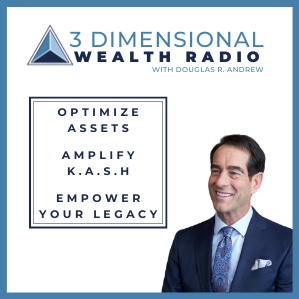When most people think of getting cash out of their financial vehicles, they think of traditional accounts like 401(k)s, where they will owe taxes on withdrawals and–if younger than age 59 ½–they’ll also pay a 10% early withdrawal penalty.
But getting cash out of an Indexed Universal Life policy can be far better–it can be accessed income-tax-free, with no early penalties, and your policy can continue to earn interest on the amount you borrow.
For the uninitiated, it might sound too good to be true–getting cash (income-tax-free) out of a life insurance policy for things like retirement, business investments, education, emergency funds, etc.? But it’s true, Indexed Universal Life policies can be one of the best ways to save–and provide for–many of life’s financial situations.
When it comes to accessing cash in your policy, however, you want to pay attention.
3 WAYS TO ACCESS YOUR CASH
In another of my articles, I explain there are three ways to access cash out of an Indexed Universal Life policy here:
- The Sad Way – By passing away–your death benefit passes to your heirs income-tax-free.
- The Dumb Way – By surrendering the policy, making outsized withdrawals during the funding years, or making withdrawals once the policy is fully funded.
- The Smart Way – By borrowing your own money from the policy, via loans.
- (For more in-depth details, check out the article “What Is the Smartest Way to Access Cash Out of an IUL?”)
This is usually where folks say, “What? Borrow my own money? Why would I borrow my own money?” Because it empowers you to access your money income-tax-free, and you don’t have to pay the loan back during your lifetime if you don’t want to.
HOW DO LOANS WORK?
When clients come to me wanting to access their money for a business venture, to help their kids with college, or for their own retirement income, they know the procedure. For example, one of my clients is a multi-millionaire investor in real estate. He usually pulls out a big chunk of change to put down earnest money on another apartment complex he wants to buy.
So he says, “Doug, send me one of those forms from the insurance company.” He’ll fill in how much he wants, which is often in the range of $1 million. Then in the section that asks if he would like to make a withdrawal or a loan, he checks “loan” every time.
He knows choosing a loan will allow him to access his money income-tax-free. Then he checks what type of loan–a Zero Wash Loan or an Alternate Loan. If the economy is struggling, he’ll choose a Zero Wash Loan. If the market is doing well, he’ll choose an Alternate Loan.
To explain, in order to call it a true loan, the insurance company has to charge a nominal interest rate. So that might be 2%. And so they charge him 2% on the million. If he chooses the Zero Wash Loan, at 2%, the insurance company is going to charge him $20,000 of interest that year on the million.
How is that covered? Well, the insurance company collateralizes his loan with his cash value, and they will credit him the exact interest rate they’re charging him. So let’s say his policy is earning just 2% that year, because the market is down. He’s still earning 2% on the $1 million he borrowed, because he did not withdraw it; it’s still sitting there. The insurance company simply used his cash value as collateral.
In other words, his money was not touched; it’s still growing. The insurance company loaned him the equivalent of the cash or the interest that he’s paying on that is credited. So if he’s earning $20,000, that covers the $20,000 in interest. That’s why it’s called a Zero Wash Loan.
If it were an up-year for the market, he might choose the Alternate Loan (also called a Participating Loan, Indexed Loan, etc.) . In this scenario, he is opting to pay a slightly higher interest rate, say 5% this year. On the $1 million loan, that would be $50,000.
Why choose to be charged more interest? Because the insurance company will credit him the indexed rate on the full million that he left in his policy by borrowing rather than withdrawing. There have been years where he borrowed at 5% and earned 16%. In 2017, his policy earned 25%.
The insurance company charged him $50,000 on his $1 million loan, but they credited him $250,000 on that same million. He was earning a net of $200,000 tax-free on his money–while he was using the money for something else! This is incredible.
PROVIDING MORE THAN CASH–PEACE OF MIND
Properly structured, maximum-funded Indexed Universal Life policies, or what I call LASER Funds, make it possible for people to retire and simply borrow money from their policy to enjoy tax-free income for the rest of their lives.
They can feel calm knowing that their money is set aside with a safe institution. They don’t fret when the market tanks, because their money is linked to the market and protected by a 0% floor in down years–it’s not vulnerable to negative returns in the market like traditional retirement accounts.
They can pay back their loans if they’d like, but many choose not to, and when they pass away, the loan balance is simply deducted from the death benefit, while the remaining money passes to their heirs income-tax-free.
So the bottom line: the way to withdraw cash from a policy isn’t to withdraw it at all, it’s all about borrowing. And about peace of mind.
WANT TO LEARN MORE?
Watch the Video – Watch the related YouTube video to see me explain “How Do You Withdraw Cash from a Life Insurance Policy?” (and while you’re there, be sure to subscribe to my YouTube channel so you don’t miss a thing!).
Elevate Your Financial Dimension – Find out how you can improve your Financial Dimension journey and seize the liquidity, safety, predictable rates of return, and tax advantages of a LASER Fund. Explore the in-depth financial strategies and learn from real-life client experiences by claiming your free copy of “The LASER Fund” book at LASERFund.com. Just pay for shipping and handling, and we will send it to you, absolutely free.
Join a Webinar – Want to find out if a LASER Fund (a maximum-funded, properly structured indexed universal life insurance policy) is right for you? Join us for an upcoming webinar where you can explore these strategies


